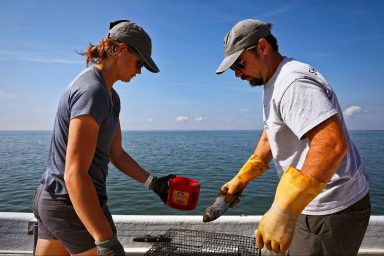Kentucky State Police Training Included Hitler’s Guidance ; Venice’s Controversial Inflatable Floodgates Save the City ; and More Picks 11/10
‘Repugnant’ Kentucky State Police Training Included Hitler’s Guidance on Violence (Reader Steve)
From the Lexington Herald-Ledger: “Gov. Andy Beshear and others reacted with outrage … after learning Kentucky State Police training materials used quotes from Adolf Hitler and advised trainees to become ‘the ruthless killer.’ … The presentation used in the past was immediately denounced by some for emphasizing violence from police rather than minimizing force and reducing conflict. The slideshow titled ‘The Warrior Mindset’ includes a quote from Hitler’s Mein Kampf: ‘The very first essential for success is a perpetually constant and regular employment of violence.’”
Infographics vs. Post-Truth: The New Disregard for Information (Dana)
The author writes, “Most people today assume a certain level of subjectivity in journalistic articles or other written texts. And yet, people put a different kind of trust in infographics: they expect infographics to deliver hard facts, well-researched analysis, and reliable information. But this special trust in infographics means that infographers have a special responsibility. And while infographics are not a primary target of ‘fake news’ accusations, the basis of their integrity is in danger: in the post-truth era, people not only disregard information provided by the news media but information in general.”
US Corn Crop’s Growing Sensitivity to Drought Revealed (Mili)
The author writes, “Like a baseball slugger whose home run totals rise despite missing more curveballs each season, the U.S. Corn Belt’s prodigious output conceals a growing vulnerability. A new Stanford study reveals that while yields have increased overall — likely due to new technologies and management approaches — the staple crop has become significantly more sensitive to drought conditions. The research … uses a novel approach based on wide differences in the moisture-holding capabilities among soils. The analysis could help lay the groundwork for speeding development of approaches to increase agricultural resilience to climate change.”
The Colonization of the Ayahuasca Experience (Peg)
From JSTOR Daily: “About a decade ago, popular interest in ayahuasca, a hallucinogenic brew, started taking off in Europe and North America, driven by high profile tales of its supposed mentally transformative healing powers. Lindsay Lohan, for example, notably claimed that it helped her let go of ‘the wreckage of [her] past life,’ resolving old traumas and allowing her to move forward. Responding to these accounts—and building on the overall revival of scientific interest in the potential medicinal uses of psychedelics—researchers have started looking into ayahuasca’s potential to help treat everything from addiction to depression to eating disorders to post traumatic stress disorder.”
Venice’s Controversial Inflatable Floodgates Save the City for the Second Time (Dana)
The author writes, “Last year, Venice declared a state of emergency when it experienced its worst floods in 50 years. The flooding caused more than $1 billion in damage, and parts of the city were left under six feet of water, including St. Mark’s Basilica, a nearly thousand-year old cathedral. This time … the barrier system of 78 floodgates — known as Mose — successfully kept Venice’s winding alleyways and historic squares clear. Instead of flooding, the tide within the lagoon only rose by 1.7 feet. … The barriers are designed to stay at the bottom of the lagoon until they are activated, at which point they fill with air and then rise to the surface. The large yellow walls then seal off three of the lagoon’s inlets, shielding the island from high tides.”



